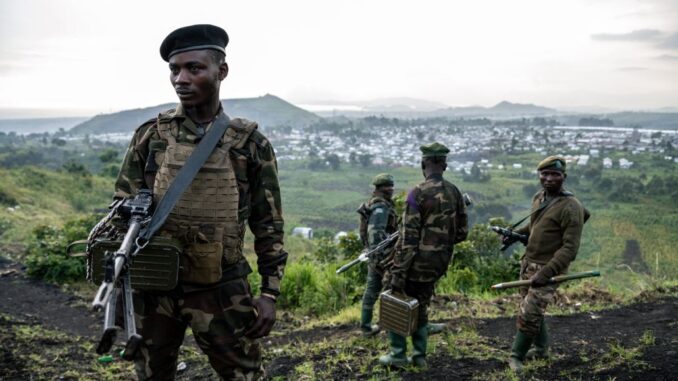
By Ezra Otieno
The events surrounding the Democratic Republic of the Congo (DRC) need a clear and informative update to convey the core of changes in Africa’s heartland. As a reminder, the Democratic Republic of Congo is a country the size of Western Europe that straddles the equator and, compared to any other African republic, is surrounded by nine different countries. It is the continent’s second-largest country by land area and fourth-largest by population, with an estimated 100 million people. It is part of the world’s second-biggest rainforest and is essential in combating climate emergencies.
Recently, the Rwandan government, especially, and to a lesser extent, the Ugandan government, has resurrected the M23, who were defeated in 2013 and fled to Rwanda and Uganda, where they remained inactive. The M23 is the latest renamed Rwanda-backed group to destabilize eastern Congo since Rwanda was forced to abandon its control over significant parts of the nation in 2002. Before its name in 2012, the M23 operated as the National Congress for the Defence of the People (CNDP in French), founded in 2006. The CNDP grew out of several Rally for Congolese Democracy (RCD) sections that arose in the late 1990s in response to Rwanda’s two Congo invasions in 1996 and 1998.
The M23 has returned, better equipped than before, and infiltrated with Rwandan soldiers who are terrorizing eastern DRC. They have captured critical territory bordering Rwanda and Uganda, exacerbating the situation for millions of Congolese who are displaced from their homes.
Concerns were raised about the M23 aiming to conquer Goma, the east’s central city with around 2 million people, and perhaps expanding into South Kivu. However, according to sources from Washington, the Biden administration intervened to prevent an all-out conflict between the DRC and Rwanda. Unlike President Obama, who delayed military aid from Rwanda because it supported the M23, the Biden administration has adopted a different approach. It has attempted to steer a process in which Rwanda’s Paul Kagame and the Democratic Republic of the Congo’s Felix Tshisekedi make concessions to reach an agreement between the two countries. The heart of the arrangement being mediated by Washington is that both parties would stop equipping militia organizations in the east of Congo.
Rwanda has frequently utilized the Rwandan militia organization, the Democratic Forces for the Liberation of Rwanda (FDLR in French), as a reason to send troops into Congo. Some members of the FDLR took part in the 1994 genocide. However, as early as 2008, the United Nations rejected the premise that the FDLR posed an existential danger to the Rwandan state. A new Africa secret assessment cites critical strategic and economic imperatives for Rwanda’s revival of the defunct M23. They include access to and control of resources such as coltan, tin, and gold; increased export profits from selling Congo’s gold to justify world trust in the country’s bond offers; and control over transportation and trade networks.
Uganda and Congo are building a new regional route, which risks cutting Rwanda off from profitable regional commerce between Mombasa and Congo.
Uganda and Rwanda have benefited from Congo’s resources since their invasions in 1996 and 1998. From 2001 to 2002, the United Nations produced a series of studies naming Paul Kagame of Rwanda and Yoweri Museveni of Uganda as the Godfathers of the Congo’s illicit mineral trade. In actuality, Rwanda and Uganda’s forces fought on Congolese land from June 5 to 10, 2000, in the so-called Six-Day War in Kisangani, DRC, reportedly over mineral ownership in the area.
Today’s agents of neo-colonialism, like Paul Kagame and Yoweri Museveni, have pillaged the country’s riches for their benefit to the detriment of the Congolese people in particular and Africa at large. This contrasts the post-independence Pan Africanists who rallied around the Congo to fortify the country for the benefit of Africa writ large.
According to reports from the United States, China has grabbed Congo’s cobalt market, excluding the United States and other Western countries. The assertion is doubtful for various reasons, the most notable being that Freeport McMoran, a US firm, controlled one of the world’s most significant copper compromises, Tenke Fungurume. However, Freeport sold its concession to the Chinese corporation China Molybdenum to pay off its debts. The New York Times stated that President Biden’s son, Hunter Biden, discussed selling the deal to the Chinese.
The United States Congress has also joined the debate, introducing two Congressional Bills by Chris Smith of New Jersey and John James of Michigan. Both men backed measures to counter China’s control and influence of cobalt in the Congo and urged the United States to strengthen its presence and access to essential minerals. Washington-based think teams have been releasing a slew of studies regarding the relevance of Congo and Africa’s minerals to the future of green energy businesses in the United States and Europe.
As China, the United States, and other nations compete for Congo’s resources, a crucial constant since the reign of King Leopold II in the late 1800s has been that Congolese continue to pay a high price for the pursuit of wealth from which they are not the primary benefactors. A stunning reality is that up to 70 million of Congo’s 100,000 million people live on less than $2.15 per day while sanctioned imperialists feast on Congo’s mining wealth.
With Tshisekedi’s win in the December 20, 2023 election, which was marred with electoral irregularities, the plunder and conflict will continue, and only an organized Socialist workers’ organization can salvage this revolutionary situation.








